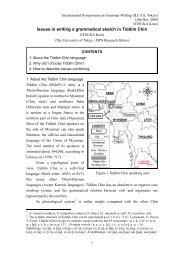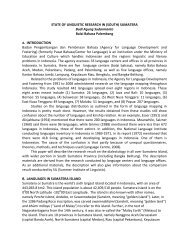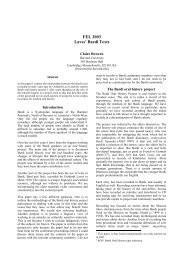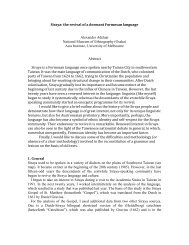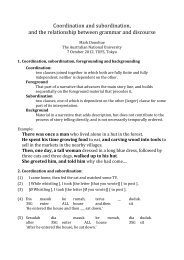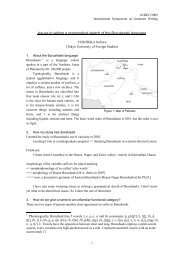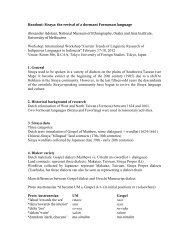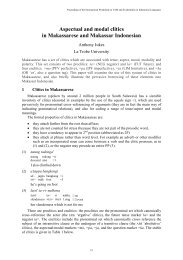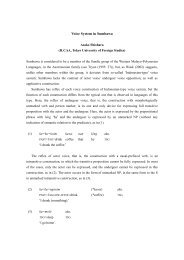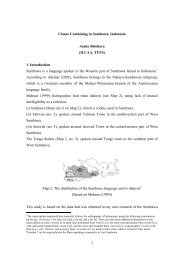Abstract for the workshop on tense, aspect, mood and evidentiality in ...
Abstract for the workshop on tense, aspect, mood and evidentiality in ...
Abstract for the workshop on tense, aspect, mood and evidentiality in ...
You also want an ePaper? Increase the reach of your titles
YUMPU automatically turns print PDFs into web optimized ePapers that Google loves.
<str<strong>on</strong>g>Abstract</str<strong>on</strong>g> <str<strong>on</strong>g>for</str<strong>on</strong>g> <str<strong>on</strong>g>the</str<strong>on</strong>g> <str<strong>on</strong>g>workshop</str<strong>on</strong>g> <strong>on</strong> <strong>tense</strong>, <strong>aspect</strong>, <strong>mood</strong> <strong>and</strong> <strong>evidentiality</strong> <strong>in</strong> Ind<strong>on</strong>esian languagesThe Analysis of <str<strong>on</strong>g>the</str<strong>on</strong>g> Semantic Functi<strong>on</strong> of <str<strong>on</strong>g>the</str<strong>on</strong>g> Prefix N- <strong>in</strong> Basilectal Jakarta Ind<strong>on</strong>esianLanny HidajatSchool of Teacher Tra<strong>in</strong><strong>in</strong>g <strong>and</strong> Educati<strong>on</strong>, Atma Jaya Catholic University of Ind<strong>on</strong>esiaThis is a prelim<strong>in</strong>ary study to exam<strong>in</strong>e whe<str<strong>on</strong>g>the</str<strong>on</strong>g>r <str<strong>on</strong>g>the</str<strong>on</strong>g> nasal prefix N- (hence<str<strong>on</strong>g>for</str<strong>on</strong>g>th, N-) <strong>in</strong>Basilectal Jakarta Ind<strong>on</strong>esian (hence<str<strong>on</strong>g>for</str<strong>on</strong>g>th, bJI) is actually a progressive marker <strong>in</strong>stead of activevoice morphology. In various studies, N-, toge<str<strong>on</strong>g>the</str<strong>on</strong>g>r with <str<strong>on</strong>g>the</str<strong>on</strong>g> null affix, is generally assumed asactive voice morphology <strong>in</strong> bJI, as represented <strong>in</strong> (1) (Tjung, 2006; Cole et al., 2006; Hidajat,2010).(1) a. Active transitive with N-verb:Oh, Tante Yanti nyuci mangkoknya?EXCL aunt yanti N-wash bowl-DET‘Oh, I am wash<strong>in</strong>g <str<strong>on</strong>g>the</str<strong>on</strong>g> bowls?’ (EXPYAN; 23;7)b. Active transitive with bare verb:Michael cuci pir<strong>in</strong>g.Michael φ-wash plate‘You (Michael) wash <str<strong>on</strong>g>the</str<strong>on</strong>g> plates.’ (RINMIC; 18;0)The assumpti<strong>on</strong> that N- <strong>in</strong> bJI has a semantic functi<strong>on</strong> is <strong>in</strong> l<strong>in</strong>e with <str<strong>on</strong>g>the</str<strong>on</strong>g> claim that <str<strong>on</strong>g>the</str<strong>on</strong>g> prefixmeN- <strong>in</strong> Malay is a progressive viewpo<strong>in</strong>t <strong>aspect</strong>ual marker (Soh <strong>and</strong> Nomoto, 2009). Thedistributi<strong>on</strong> of N- <strong>in</strong> bJI is briefly reviewed below.Although N- is an active voice marker, it is not very productive. N- generally appearswith eventive transitive verbs, as exemplified <strong>in</strong> (2).(2) Ni ulernya lagi ngejar ayam...this snake-DET PROGRESS N-chase chicken‘This snake is chas<strong>in</strong>g <str<strong>on</strong>g>the</str<strong>on</strong>g> chicken.’ (EXPOKK; 25:5)However, N- generally cannot be affixed to stative transitive verbs, except to a few, such assangka ‘suspect’ (becomes nyangka) <strong>and</strong> kira ‘reck<strong>on</strong>’ (becomes ngira), as shown <strong>in</strong> (3).(3) … dia ngira aku mahasiswa luar negeri…3sg N-reck<strong>on</strong> 1sg student out country‘…he thought that I was a <str<strong>on</strong>g>for</str<strong>on</strong>g>eign student…’ (Habiiballah, 2005: 63)N- can appear more freely with stative transitive verbs if <str<strong>on</strong>g>the</str<strong>on</strong>g>y are also affixed by <str<strong>on</strong>g>the</str<strong>on</strong>g> suffix –IN,which can be an object marker, as shown <strong>in</strong> (4).(4) … Opi gak *ngenal/ngenal<strong>in</strong> suara Tante, ya?Opi NEG N-recognize/N-recognize-IN sound aunt yes‘You didn’t recognize my voice, didn’t you?’ (EXPERN: 26:1)
N- can also be affixed to <strong>in</strong>transitive verbs. However, <str<strong>on</strong>g>the</str<strong>on</strong>g> distributi<strong>on</strong> of <strong>in</strong>transitiveverbs with N- is limited as well as erratic. N- can be affixed to some unergative verbs, such aslompat ‘jump’ (becomes ‘ngelompat’) <strong>and</strong> umpet ‘hide’ (becomes ‘ngumpet’), <strong>and</strong> someunaccusative verbs, such as tempel ‘attach’ (becomes ‘nempel’) <strong>and</strong> sangkut ‘hook’ (becomesnyangkut) <strong>and</strong> leleh ‘melt’ (becomes ngeleleh). N- appears more freely with <strong>in</strong>transitive verbswhich have been transitivized as <str<strong>on</strong>g>the</str<strong>on</strong>g> result of be<strong>in</strong>g affixed by <str<strong>on</strong>g>the</str<strong>on</strong>g> suffix –IN, which can alsobr<strong>in</strong>g <str<strong>on</strong>g>for</str<strong>on</strong>g>th causative <strong>in</strong>terpretati<strong>on</strong>, as exemplified <strong>in</strong> (5).(5) N- + terbang ‘fly’ + -IN nerbang<strong>in</strong> ‘to make someth<strong>in</strong>g fly’… sampe-sampe dia nerbang<strong>in</strong> pesawat kertas…RED-arrive 3sg N-fly-IN airplane paper‘…so that he flied a paper airplane…’ (Yunadi, 2007:24)N- can also be affixed to nouns. Nouns which are affixed by N- become unergative verbs,as shown <strong>in</strong> (6). Only a limited number of nouns can appear with N-, some of <str<strong>on</strong>g>the</str<strong>on</strong>g>m are kopi‘coffee’, teh ‘tea’, <strong>and</strong> rujak (name of a k<strong>in</strong>d of dish).(6) Tante ngopi.aunt N-coffee‘I’m dr<strong>in</strong>k<strong>in</strong>g coffee.’ (JNBRIS; 37:7)Based <strong>on</strong> <str<strong>on</strong>g>the</str<strong>on</strong>g> fact that N- is restricted to appear with stative verbs, <strong>on</strong>e may argue that N-verbs <strong>in</strong> bJI are n<strong>on</strong>-stative verbs. But, <str<strong>on</strong>g>the</str<strong>on</strong>g>re is a twist to this argument. In general, N-verbs arerestricted to imperatives:(8) Kejar/*ngejar kak Icanya!chase/N-chase TRU.older.sibl<strong>in</strong>g Ica-DET‘Chase Ica!’ (EXPDAL; 28:4)As po<strong>in</strong>ted out by Dowty (1979), <strong>on</strong>ly n<strong>on</strong>-statives can occur as imperatives. The fact that N-verbs cannot be used <strong>in</strong> imperatives c<strong>on</strong>tradicts <str<strong>on</strong>g>the</str<strong>on</strong>g> argument that N-verbs are n<strong>on</strong>-stative verbs.To summarize, this is a prelim<strong>in</strong>ary study to determ<strong>in</strong>e whe<str<strong>on</strong>g>the</str<strong>on</strong>g>r N- <strong>in</strong> bJI actually functi<strong>on</strong>sas a progressive marker or not. This assumpti<strong>on</strong> is supported by <str<strong>on</strong>g>the</str<strong>on</strong>g> fact that N- almost neverappears with stative verbs. However, it is c<strong>on</strong>tradicted by <str<strong>on</strong>g>the</str<strong>on</strong>g> fact that N-verbs are restricted toimperatives.ReferencesCole, P., Herm<strong>on</strong>, G., <strong>and</strong> Tjung, Y.N. (2006). Is <str<strong>on</strong>g>the</str<strong>on</strong>g>re pasif semu <strong>in</strong> Jakarta Ind<strong>on</strong>esian?Oceanic L<strong>in</strong>guistics, 45, 65-90.Dowty, D. R. (1979). Word Mean<strong>in</strong>g <strong>and</strong> M<strong>on</strong>tague Grammar. Dordrecht: Reidel.Gil, D. & Tadmor, U. (2007). The MPI-EVA Jakarta Child Language Database. A jo<strong>in</strong>t projectof <str<strong>on</strong>g>the</str<strong>on</strong>g> Department of L<strong>in</strong>guistics, Max Planck Institute <str<strong>on</strong>g>for</str<strong>on</strong>g> Evoluti<strong>on</strong>ary Anthropology<strong>and</strong> <str<strong>on</strong>g>the</str<strong>on</strong>g> Center <str<strong>on</strong>g>for</str<strong>on</strong>g> Language <strong>and</strong> Culture Studies, Atma Jaya Catholic University.
Habiiballah, S.R. (2005). Jangan Lepas Jilbabku!: Catatan Harian Seorang Waria. Yogyakarta:Galang Press.Hidajat, L. (2010). The Acquisiti<strong>on</strong> of Verb Argument Structure <strong>in</strong> Basilectal Jakarta Ind<strong>on</strong>esian.Doctoral dissertati<strong>on</strong>, University of Delaware, Newark, DE.Tjung, Y.N. (2006). The Formati<strong>on</strong> of Relative Clauses <strong>in</strong> Jakarta Ind<strong>on</strong>esian: A Subject-ObjectAsymmetry. Doctoral dissertati<strong>on</strong>, University of Delaware, Newark, DE.Yunadi, A.L. (2007). Dua Belas Pendar B<strong>in</strong>tang. Jakarta: Gramedia.



